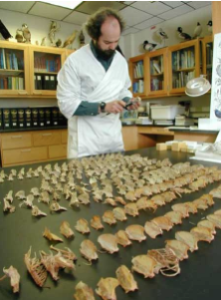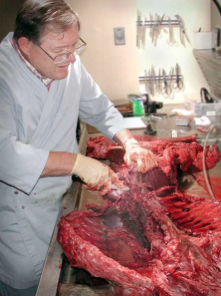The Wildlife Forensic Lab’s Science Teams
The wildlife crime lab’s six science teams examine evidence submitted by agents. Their work centers on identifying the species or subspecies of pieces, parts or products of an animal and determining the cause-of-death of an animal.
 Criminalistics
Criminalistics
The Criminalistics unit analyzes trace evidence found at crime scenes, such as fingerprints, bullets, fiber and tool marks, to find out what happened to the victim. Each type of analysis is complex and detailed. For example, bullet analysis assesses the many physical features left on a bullet, such as caliber, twist, land and groove width, to first infer the type of firearm used to fire the projectile, and then to match it to a specific gun.
 Chemistry
Chemistry
The Chemistry unit assesses the elemental components of animal blood and tissue from a range of products, like organs and powdered medicines. Its casework examines the chemical structure of blood, tissue and other animal parts to identify species and analyze the cause of death. For example, it identifies agriculture poisons, pest control agents and industrial chemicals in order to determine why and where an animal died.
 Morphology
Morphology
The Morphology section examines items like fur, hides, feathers, claws, and teeth both visually and microscopically and then uses their form and structure to determine what species they came from. They use classic comparative anatomy techniques to identify the species of animal from its parts. For instance, if the entire carcass is available, then it can use all characteristics of body size, shape, and external markings.
 Pathology
Pathology
The Pathology unit performs necropsies (animal autopsies) on relatively intact carcasses to ascertain the cause and process of death. Similar to a medical examiner, the lab’s wildlife pathologists try to determine the cause, mechanism and manner of death. The “cause” of death is the disease injury or abnormality that directly contributed to the animal’s demise. The “mechanism” of death implies the physiological consequences of the injury or disease, wh ile the “manner” of death refers to the circumstances (including relationships and causal factors) that initiated the cause of death.
Genetics
The Genetics section analyzes DNA to identify both species and individuals. It uses modern molecular genetics techniques to identify plant and animal remains and products and determine their taxonomic family, species, and sub-species, as well as gender, parentage, or population (geographic) origin.
Digital Analysis
The Digital Analysis unit analyzes computer, audio and video evidence and helps develop court displays.
